Contrary to its popular image as a hotbed of Islamic fundamentalism, Syria is a remarkably safe and tranquil holiday destination with warm, cultured, tolerant and well-educated people. Indra Gidwani describes an enchanting visit
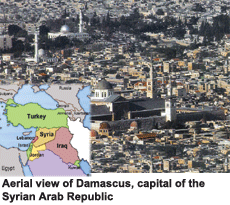 Although routinely demonised by Western and particularly the US media as a troublesome rogue nation, the Syrian Arab Republic (SAR, pop: 23 million), popularly known as Syria, is remarkably safe and tranquil, even though it is surrounded by the troubled countries of Iraq, Israel, Palestine and Lebanon. Syria is also the headquarters of the Shia Islamist paramilitary organisation — Hezbollah. Despite that, and its unsettled dispute with Israel over the Golan heights, there’s been no firing across the Syrian border for over 30 years. SAR offers extraordinary sights and extraordinary people — warm, cultured, tolerant, hospitable, courteous and well-educated. Most visitors to this country end up developing a life-long infatuation with its gentle charm.
Although routinely demonised by Western and particularly the US media as a troublesome rogue nation, the Syrian Arab Republic (SAR, pop: 23 million), popularly known as Syria, is remarkably safe and tranquil, even though it is surrounded by the troubled countries of Iraq, Israel, Palestine and Lebanon. Syria is also the headquarters of the Shia Islamist paramilitary organisation — Hezbollah. Despite that, and its unsettled dispute with Israel over the Golan heights, there’s been no firing across the Syrian border for over 30 years. SAR offers extraordinary sights and extraordinary people — warm, cultured, tolerant, hospitable, courteous and well-educated. Most visitors to this country end up developing a life-long infatuation with its gentle charm.
Certainly, Syria doesn’t deserve the reputation of a nation drifting towards Islamic fundamentalism. Although officially described as an Arab republic, it hosts a population proud of its ancient civilisation and diverse cultures dating back over 10,000 years. It has been ruled by Sumerians, Amonites, Akkadians (Islamic civilisations such as Umayyads, Abbasids, Fatimids, Mamlukes and Ottomans), Hitites, Pharaohs, Greeks, Seleucids, Romans, Nabateans, Byzan-tines, Gassanids and finally the French from whom it attained independence in 1946. Contemporary Syria is a melting pot of many cultures. Far from being insular, by Middle East standards Syrian society is liberal and well integrated.
Although as its official nomenclature implies, Syria is predominantly an Arab (90 percent) country, it also hosts large minorities from other ethnic groups — Kurds, Armenians, Caucasians and Turks. The official language is Arabic but other languages spoken are Kurdish, Armenian, Turkish, French and English.
Since Bashar-al-Assad took over the reins as president of the Syrian Arab Republic in 2001, modernisation has been a top national priority. First lady Asma Assad, a former financial analyst, is credited with introducing innovative reforms from micro-lending to schools for the autistic. Contemporary Syria is way ahead of its neighbours in terms of women’s rights, education and emanci-pation. Female literacy is 86 percent.
Syrians seem content under the relatively progressive dictatorship of the Assad family. In the country’s secular environment, the Christian minority enjoys full freedom of worship. For tourists — particularly from the Indian subcontinent — Syria is utterly safe. There is no record of any tourist being mugged or kidnapped and women can venture out even in the small hours. Religious zealotry is rare and visitors are not harassed by self-styled guides or souvenir vendors.
For visitors the unique proposition Syria offers is its rich history and full share of historical treasures, immacu-lately maintained through the centuries. The ancient cities of Damascus, Aleppo and Bosra are all included in UNESCO’s World Heritage List, as are the sensational Roman ruins of Palmyra. Mighty castles dating back to the Crusaders, labyrinthine medieval souks, jewel-like Damascene houses, sacred Umayyad mosques, mysterious ‘dead cities’ are some of the highlights ripe for exploration. These monuments interest-ingly, are still part of the daily lives of the population. Locals worship in the mosques, shop in the souks, drink tea in heritage homes and picnic in ruins. And they are pleased when travellers join them.
Damascus
A visitor’s first port of call in the Syrian Arab Republic is usually Damascus, the capital. Legend has it that Prophet Mohammed (PBH) looked down on Damascus from Jebel Qassioun, the mountain to the north-west of the city and turned his back on Mecca, saying that man could enter Paradise only once. At the top of the mountain is the Al Arba’een Shrine, where the world’s first woman, Eve, is believed to have lived, after her son Cain killed Abel, the world’s first murder victim. A taxi ride of 4-5 Syrian pounds (US $1=45 SP) takes you to Jebel Qassioun. Sitting in one of the cafes up there, sipping a drink (alcohol is freely available), you could take in a breathtakingly spectacular view of the city below, which emanates emerald green lights from its mosques.
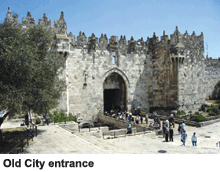 One of the oldest continuously inhabited cities on earth — 5,000 years and counting — Damascus (pop. 7 million) is a verdant oasis resting in the shade of the Ghuta orchards and servi-ced by the waters of Barada. It’s a shimmering, walled city of white set in a green ambience beyond whose gold-en domes, tapering minarets, meandering alleys, gardens and orange groves, the desert fades into the horizon.
One of the oldest continuously inhabited cities on earth — 5,000 years and counting — Damascus (pop. 7 million) is a verdant oasis resting in the shade of the Ghuta orchards and servi-ced by the waters of Barada. It’s a shimmering, walled city of white set in a green ambience beyond whose gold-en domes, tapering minarets, meandering alleys, gardens and orange groves, the desert fades into the horizon.
The Old City where the apostle Paul experienced the legendary Pauline conversion which transformed him into the first Christian missionary, has changed little in the past millennia, and is a complex of towers and ancient walls, built by the Greeks and Romans. It contains the most exotic souk in the Middle East, one of Islam’s grandest mosques and an old quarter seemingly frozen in time with a cast of historical characters including Saladin, Hadrian, Nebuchadnezzzar, Tamerlane, Alexander the Great, St. Paul and Lawrence of Arabia.
Al Hamidiya Souk. The most imposing entrance into the Old City is through Al Hamidiya, Damascus’ most vintage and largest souk. It dates back to the reign of the Ottoman Sultan Abdul Hamid after whom the souk is named, and is covered with high iron vaulting, so old that the sun’s rays filter through it to light up the souk.
Al Hamidiya is the buzzing nerve centre of the Old City. From dawn to dusk traders, hawkers, shoppers and gawkers throng its winding alleys amid a riot of colour and a hubbub of cries and shouting. Laden with goods ranging from Persian carpets, perfumes, damask fabric, embroidered kaftans and garments to woodcraft studded with mother-of-pearl, Syrian sweets (similar to Lebanese and Turkish), spices and dry fruits, Al Hamidiya is far removed from glitzy modern-day malls, but has stubbornly retained its traditional attraction, and is in no danger of extinction. Within its medieval maze is the famous Khan As’ad Pasha, one of the 18 surviving khans — two-storeyed warehouses/caravanserais built in the 15-18th centuries as lodgings for merchants and traders plying the busy trade routes of the Middle East. Khan As’ad Pasha is particularly attractive with black and white stonework, spherical domes and carved arches enclosing a central courtyard.
A huddle of no-frills cafes near the market entrance offer thick Turkish-style coffee and local ice-cream known as bouza arabiyah. A hearty snack of Syrian shawarma downed with fresh pomegr-anate juice should not be missed in these cafes.
Umayyad Mosque. From the end of Al Hamidiya, walk right into the Umayyad Mosque — “the first monumental work of architecture in Islamic history”. To enter the mosque you have to wear a special beige colo-ured, hooded, ankle-length modesty robe available at the entrance which leads into an enormous courtyard surrounded by green and gold mosaic- studded columns and arches. A striking feature of the mosque are its three minarets built in different styles guarding a magnificent greyish-blue dome. Its arabesque decoration is well preserved.
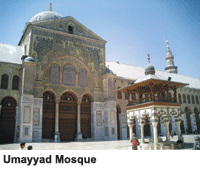 Worship here goes back at least 3,000 years, when the Arameans built a temple to Hadad, the levantine rain God. The Romans subsequently built a Temple of Jupiter, four times larger than the present mosque. Later it was turned into the St. John the Baptist Church. Following the Islamic conquest, this mosque was built in 705 AD by Caliph Al-Walid, one of the earliest Muslim rulers, whose Umayyad dynasty forged an empire that stretched from the French Pyrenees to the borders of China. For the first 70 years of the mosque’s existence, Muslims and Christians prayed here together. Under a shrine within the Umayyad mosque lies buried the head of St. John the Baptist — executed by King Herod of Judea in 33 AD.
Worship here goes back at least 3,000 years, when the Arameans built a temple to Hadad, the levantine rain God. The Romans subsequently built a Temple of Jupiter, four times larger than the present mosque. Later it was turned into the St. John the Baptist Church. Following the Islamic conquest, this mosque was built in 705 AD by Caliph Al-Walid, one of the earliest Muslim rulers, whose Umayyad dynasty forged an empire that stretched from the French Pyrenees to the borders of China. For the first 70 years of the mosque’s existence, Muslims and Christians prayed here together. Under a shrine within the Umayyad mosque lies buried the head of St. John the Baptist — executed by King Herod of Judea in 33 AD.
Ananias Chapel. Winding paths through a tangle of back lanes lead to the aptly nomenclatured Straight Street — an ancient, cobbled Roman road that cuts through the middle and ends at St. Ananias Chapel. One of the apostles of Jesus and the first bishop of Damascus, Ananias, a contemporary of St. Paul, played an important role in Christian and Islamic history. The Acts of the Apostles recounts how Ananias is commanded by the Lord in a vision to go to the “Street called Straight” (Acts 9:11) to meet Saul (later St. Paul) in the house of Judas, after the former is struck blind by divine commandment for persecuting the first Christians. Ananias healed Saul’s blindness with a blessing, baptised him and prophesied his apostolate to all people.
Syria takes enormous pride in its pre-Muslim history. Ten percent of its population, and the Christian quarter of Damascus is replete with old churches of several denominations, including Greek Orthodox, Syrian Orthodox, Rom-an Catholic, Maronite and Armenian.
Damascus National Museum. The largest museum in Syria, it contains treasures from 4,000 archaeo-logical sites across the country. The artefacts included are of Assyrian, Chaldean, Hittite, Phoenician, Persian, Greek, Nabatean, Roman, Byzantine, Arab, Crusader, Mameluke, Ottoman and even French eras and the several other dynasties that ruled Syria. Enhancing the exhibits is a 1,400 BC tablet with the world’s first recorded alphabet and another tablet with the world’s first recorded musical notation.
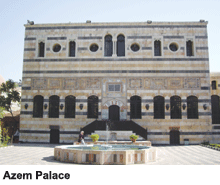 Old City. Amid the prosaic chaos of the old quarters is a conglomeration of extravagant Damascene houses, featuring exquisite fountain-splashed courtyards. A striking example of a traditional house, in which simple, almost primitive, exteriors contrast in sharp relief with the beauty and sophistication within, is the Azem Palace which currently houses the Museum of Arts and Popular Traditions. Located to the south of the Umayyad Mosque, the palace was built in the mid-18th century for the governor of Damascus. Like Azem Palace, a few of these crumbling mansions have been saved by a cultural renaissance drive undertaken in the past decade. Enterprising restaurateurs have contributed to their salvation by transforming some homes with their charming courtyards into restaurants offering palate-friendly native cuisine, washed down with iced mint and lemon tea and excellent Syrian beer.
Old City. Amid the prosaic chaos of the old quarters is a conglomeration of extravagant Damascene houses, featuring exquisite fountain-splashed courtyards. A striking example of a traditional house, in which simple, almost primitive, exteriors contrast in sharp relief with the beauty and sophistication within, is the Azem Palace which currently houses the Museum of Arts and Popular Traditions. Located to the south of the Umayyad Mosque, the palace was built in the mid-18th century for the governor of Damascus. Like Azem Palace, a few of these crumbling mansions have been saved by a cultural renaissance drive undertaken in the past decade. Enterprising restaurateurs have contributed to their salvation by transforming some homes with their charming courtyards into restaurants offering palate-friendly native cuisine, washed down with iced mint and lemon tea and excellent Syrian beer.
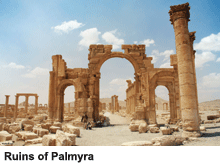 Ruins of Palmyra. Established in the first century BC by the Romans, Palmyra was the capital of warrior Arab Queen Zenobia in the 3rd century BC, who took on the mighty Roman empire and liberated the city from their domination until the Romans wrested it back at the end of the century. Situated in the heart of the Syrian desert, while viewing the ruins of this once-magnificent Roman city, you can marvel at the splendour of a thousand columns undisturbed by swarms of tourists.
Ruins of Palmyra. Established in the first century BC by the Romans, Palmyra was the capital of warrior Arab Queen Zenobia in the 3rd century BC, who took on the mighty Roman empire and liberated the city from their domination until the Romans wrested it back at the end of the century. Situated in the heart of the Syrian desert, while viewing the ruins of this once-magnificent Roman city, you can marvel at the splendour of a thousand columns undisturbed by swarms of tourists.
Famed for its Bel Temple showcasing a grand repetitive colonnade of 1,000 columns with Corinthian crowns stretching for more than a thousand metres, the ruins offer vistas of the haunting Valley of Tombs.
Aleppo
One of the oldest inhabited cities of the world and a UNESCO World Heritage site, Aleppo is Syria’s second largest city. Once a thriving commercial centre on the Silk Route, it boasts an ancient connection with peninsular India and Kerala in particular. Indeed, this southern India state’s 6 million-strong Syrian Christian community owes its sectarian faith to Aleppo’s once-thriving Syriac Orthodox Church, whose missionaries were active in Kerala from 345 AD.
Charged with history going back to the third millennium BC when it was the capital of the Amonite kingdom, Aleppo has been captured, conquered, destroyed and re-built many times over. A mute witness to its turbulent history is the Citadel of Aleppo, arguably Syria’s most impressive historical monument and a remarkable example of military architecture in the Middle East.
Widely revered as the third city of the Islamic world because of its large number of mosques and madrasa schools, Aleppo is no less known for its churches and hosts a large Armenian population which lives in harmony with the Muslim majority and patronises its own schools, colleges, churches and clubs.
Contemporary Aleppo (pop:5 million) is an important centre for processing and marketing cotton, wheat, olives and pistachio nuts. It is also renowned in Syria and the Middle East for its culinary sophistication and is a centre of Arabic music, particularly the famous Qudood music admired across the Arab world.
An hour’s drive from Aleppo is the beautiful Saint Simeon Cathedral built by Emperor Zenon 1,500 years ago to honour Saint Simeon who lived for 40 years on a pillar from where he preached to huge audiences. This cathedral is an example of the aesthetics attained by Syrian architecture which strongly influenced the design and architecture of European churches three centuries later.
The Dead Cities. Not far from Aleppo (30 km) are the mysterious Dead Cities comprising more than 600 archaeological sites: ruins of grand tombs, churches, monasteries, beautiful country houses. Among the important stone villages or dead cities are Al Bara, dotted with pyramidal tombs and Serjellah, another once-famous city.
Half-way down on the road to Damas-cus from Aleppo, stop over at the Krak Des Chevaliers, a grand fortress built during the Crusades (1095-1291 AD) and described by Lawrence of Arabia as “the finest castle in the world’’. Constructed on the edge of a volcanic crater and soaring skywards, the castle overlooks the fertile plain of Homs ringed by the Latakia mountains. The prize of two centuries of bloody and brutal struggles between Arabs and the Franks, it was liberated in 1271 by Sultan Al Zaher Baybars, who rebuilt the ruined area and added many new buildings. For visitors to Syria, this spectacular 12th century castle is a popular day excursion.
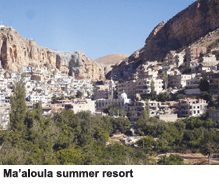 On the famous road to Damascus, in the summer resort of Ma’aloula (‘memory of rocks and man’) is St. Takla, the oldest convent in Christian history (60 AD). Today people of all faiths and religions worship at the shrine of St. Takla, one of the first saints of Christianity.
On the famous road to Damascus, in the summer resort of Ma’aloula (‘memory of rocks and man’) is St. Takla, the oldest convent in Christian history (60 AD). Today people of all faiths and religions worship at the shrine of St. Takla, one of the first saints of Christianity.
Ma’aloula is a world away from the frenzy of Damascus. Interestingly, its people still speak Aramaic, the language of Jesus Christ. Aramaic was kept alive by the St. Bacchus Church, which runs an institute to teach Aramaic to scholars from all over the world. Inhabited by a predominantly Christian populace, Ma’aloula is a rocky village sited in the Al-Qalamoon Mountains, and seems to have changed little in centuries. Its ecology, traditions and folk festivals are well preserved.
The Syrian Embassy in New Delhi would be well-advised to liberalise its visa issuance regime and processes for Indian tourists, to facilitate their journeys of discovery and conversion on the Road to Damascus!
|
Syria notebook
There aren’t any direct flights to Syria since Syrian Airlines discontinued its service from India in 2006. However, all Middle Eastern airlines including Emirates, Qatar, Etihad, Gulf Air, Saudi Arabia, Egypt Air, Kuwait Airways fly to Damascus, with a stopover in their respective headquarters. All these airlines fly to Damascus from Mumbai, Delhi, Chennai and Bangalore.
Tourist season. Given its desert climate, temperatures in SAR are extreme in mid-winter and summer. March to May and September to November are ideal months to visit.
Currency. Syrian pound. US 1 $ = around 45 Syrian pounds.
Accommodation. Hotel room prices are on a par with India ranging from $45 upwards (3-star) to $125 upwards (5-star).
|